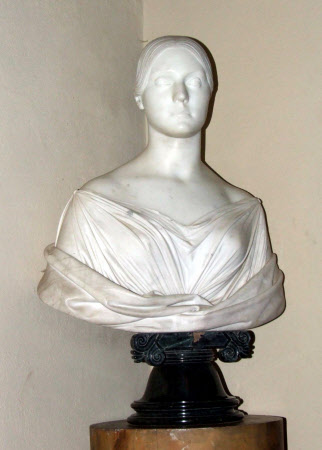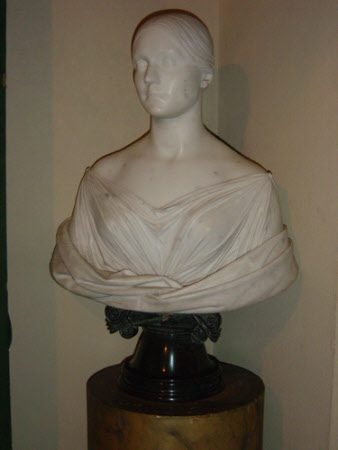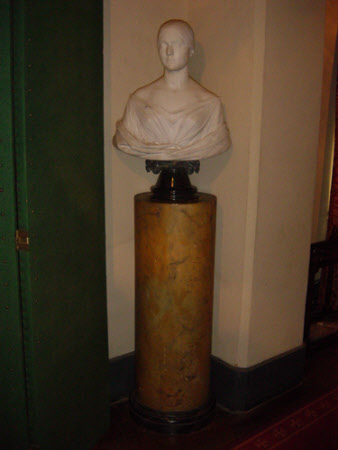Portrait of Yolande Lyne Stephens (Yolande Marie-Louise Duvernay, 1812-1894)
Lorenzo Bartolini (Vernio, Tuscany 1777 – Florence 1850)
Category
Art / Sculpture
Date
1845
Materials
White marble on a verde di Prato green marble socle
Measurements
1890 mm (H); 610 mm (H); 530 mm (W); 260 mm (D); 170 mm (H); 240 mm (W); 780 mm (H)
Place of origin
Florence
Order this imageCollection
Oxburgh Hall, Norfolk
NT 1210487
Summary
Sculpture, marble; Portrait bust of Yolande Lyne Stephens (née Duvernay, 1812-1894); Lorenzo Bartolini (1777-1850); Italy, Florence, c.1845. A portrait bust of the celebrated French dancer Yolande Marie-Louise Duvernay who in 1837 became the mistress of the wealthy Englishman Stephens Lyne Stephens (1801-1860). Following their marriage in 1845, the couple made a honeymoon tour to the Continent. The bust was made during the couple’s stay in Florence by Lorenzo Bartolini, the leading Florentine sculptor of his day.
Full description
A marble portrait bust of Yolande Marie-Louise Duvernay, Mrs Stephens Lyne Stephens (1812-1894), the sitter depicted wearing a dress in the form of the Greek garment known as a chiton, fastened with button-like clasps at each shoulder. Around the lower part of the bust is a shawl that twists and wraps around the sitter’s body. She looks slightly to her right, her hair is parted in the middle and gathered at the back, twisted into a bun. The bust is mounted on a socle made from verde di Prato marble, in the form of a tablet flanked by stylised acanthus leaves and flowers. There is damage to the base at its centre, partly repaired with clay infill painted over, some of the painted surface now lost to reveal the clay. Yolande Duvernay was born in Paris in December 1812, the child of parents who had both been active in the world of dance. At the age of just seven Yolande was enrolled in the Paris School of Dance, one of thousands of young girls derisively known as the 'petit rats', who were mainly from poor families and who attended this famous school in the early decades of the nineteenth century, when ballet and dance were at a peak of public popularity. Yolande was subsequently taught by the celebrated ballet master Auguste Vestris (1760-1842). She made her debut, using the stage name Pauline Duvernay, in 1831 at the Paris Opera House, then under the direction of Dr Louis Véron, whose mistress she quickly became. Yolande Duvernay’s dancing career, in Paris and in London, lasted for just six years, from 1831 to 1837. Although she was never regarded as the very greatest of the dancers on the stage at this time, she was certainly admired for the gracefulness of her dancing and her gentle, modest stage presence (Beaumont 1935, pp. 9-18), but also her great beauty. The scenery painter for the Paris Opera Charles Séchan (1803-1874) wrote many years later in his memoirs that ‘Duvernay was one of the most ravishing women you could wish to see. She was twenty, had charming eyes, an admirably turned leg, and a figure of perfect elegance.’ (cited in Beaumont 1935, p. 16). The young William Makepiece Thackeray went to see her perform in 'The Maid of Cashmere' at Drury Lane early in 1833 and wrote ‘When I think of Duvernay prancing in as the Bayadère, I say it was a vision of loveliness such as mortal eyes can’t see nowadays.’ (Roberts 2016, p. 15). Contemporary prints of Yolande Duvernay in her dance roles emphasise her especially elegant swan-like neck, a feature that Lorenzo Bartolini caught beautifully in his portrait of her. Like other contemporary stars of ballet such as Marie Taglioni (1804-1884) and Fanny Elssler (1810-1884), Yolande Duvernay was besieged by admirers and took numerous lovers. In 1837 though, she met and became the mistress of Stephens Lyne Stephens (1801-1860), the heir to an immense fortune based on glass manufacturing in Portugal. When in 1851 he inherited from his father Charles, Stephens would be described as ‘the richest commoner in England’. Yolande and Stephens finally married, on 14 July 1845, thereafter living at the Grove in Roehampton and at Lynford Hall in Norfolk. Sadly the marriage did not bring the respectability and entrée into society for which Yolande had longed. After her husband’s death she became increasingly involved with the Catholic church, supporting many ventures and providing the funds for the building of the Church of Our Lady and the English Martyrs in Cambridge (built 1885-1891). Yolande Lyne Stephens and her husband also built an important collection of Old Master paintings and decorative arts, a few items from which are now in the National Gallery and the Victoria and Albert Museum (Griffith-Jones 2020). After their marriage in July 1845 Stephens and Yolande Lyne Stephens made a honeymoon tour of Europe, spending time in Florence, where the portrait bust of Yolande Lyne Stephens was commissioned from the sculptor Lorenzo Bartolini (1777-1850). Bartolini’s original plaster model, from which the marble bust would have been worked up, is in the Galleria dell’Accademia in Florence (Inv. Sculture 1914), one of around 300 plasters for portrait busts that survive with other contents of the sculptor’s studio in the Accademia. Lorenzo Bartolini was regarded in his lifetime as one of the very greatest European sculptors. He was trained in the neo-classical tradition that reached a height of popularity in the first decades of the nineteenth century. Born to a poor family, Bartolini grew up and undertook early training as a sculptor in Florence, before moving to Volterra, where he studied with the French sculptor in alabaster, Barthélemy Corneille (c. 1760–1812). Whilst working for Corneille, Bartolini came across drawings by the British neo-classical sculptor John Flaxman (1755-1826), which made an enormous impact on him. A supporter of the revolutionary movements sweeping through Europe at this time, Bartolini served in the French army before moving to Paris, where he worked in the studio of the painter Jacques-Louis David. He also at this time struck up a close friendship with another up-and-coming painter, Jean-Auguste-Dominique Ingres (1780-1867). Bartolini became one of the favoured artists of the Emperor Napoleon I and his entourage, even following the defeated emperor into exile on the island of Elba in 1814. After Napoleon’s final defeat at Waterloo, Lorenzo Bartolini established his studio in Florence. His reputation as a diehard Bonapartist meant that for a long time he was denied access to larger public commissions, so instead was obliged to make his living largely through privately commissioned sculpted portraits. He soon became the most fashionable portrait sculptor in Florence, making portraits of many of the foreign visitors, a good number of them British and Irish, who flocked to Florence after peace had finally returned to Europe. Bartolini himself estimated that he had between 1816 and 1846 made and dispatched to his clients around 500 portrait busts (Tinti 1936, II, p. 11). The surviving contents of his studio, now in the Galleria dell’Accademia in Florence, includes around 300 surviving models for these portrait busts, as well as most of the models for his funerary and ideal sculptures. Bartolini had always been closely interested in Italian art of the earlier periods and, as his career developed, his style evolved towards a manner that reflected the revival of interest in the art of the Renaissance. Over a period of some four decades, Bartolini’s studio was on the itinerary of almost any wealthy British, French or other foreign visitor to Florence. In 1821 the Irish writer Sydney (Lady) Morgan published her description of her visit, writing that ‘the studio of a sculptor is always a delightful place to visit: that of Signore Bartolini is particularly so to an English traveller, because it is a " brief abstract and chronicle of the times" and country to which he belongs; where a physiognomist might give a lecture on British heads, from subjects supplied by those three great councils of the nation — the House of Lords, the House of Commons, and Almack's. There is scarcely a living bust in Great Britain, on which fashion has set her mark, or notoriety stamped her signature, that may not be found in the studio and galleries of Signore Bartolini, dispersed among the heads of antique sages or republican worthies.’ (Morgan 1821, II, p. 165). Three decades later in 1847, thus a couple of years after the Lyne Stephens had commissioned the portrait of Yolande, the British painter William Blundell Spence (1814-1900), who lived in Florence, wrote in similar terms: ‘About the middle of the street is a small wooden door; this is the entrance to the studio of the famous sculptor Bartolini, whose name is known all over Europe. Bartolini has risen entirely by his own merit and talents […] There has been scarcely any person of note who has passed through Florence for the past 30 years, but that he has had his bust executed by Bartolini, so that his studio is a sort of museum of celebrities present and past’. (Spence 1847, p. 10). According to William Blundell Spence, Lorenzo Bartolini had sought in his work to move away from the rigid neo-classicism popular in France in the decades around 1800 and, instead, to form ‘a particular school and style of his own, with this maxim for its base, study and copy nature as closely as you can.’ Although inevitably with such a large production, there are repetitions in poses, concepts and dress, Lorenzo Bartolini’s portrait busts do collectively demonstrate a genuine attempt to evoke the characters and individuality of their subjects. In the case of Yolande Lyne Stephens, Bartolini would certainly have responded to his sitter as a famous performing artist. As his friend the French painter Jean Auguste Dominique Ingres noted, Bartolini was a keen amateur musician and a passionate lover of the theatre (by which would also have been meant musical theatre and ballet). Thus, Ingres wrote to a friend of how he would dine each evening with Bartolini ‘until it is time for the theatre, to which he goes every evening of his life’ (‘jusqu’à l’heure du théâtre où Bartolini va tous les soirs de sa vie’; Letter written from Florence by Jean Auguste Dominique Ingres, to Jean-François Gilibert, 20 April 1821. Daniel and Marie-Jenne Ternois 2005, Lettres d’Ingres à Gilibert, Paris 2005, p. 174). The sculptor’s empathy for performing artists can also be seen in the closely related portrait bust of the singer Carolina Ungher Sabatier (1803-1877) in the Musée Fabre in Montpellier, also made in the 1840s (Bartolini 2011, pp. 294-95, no. 47). Just like Yolande Duvernay, Ungher rose to prominence in the 1830s, to become one of the most famous singers of her day. The bust sections of the two sculptures, with their refined ancient Greek chiton dress and a twisted drape around the lower part, are almost identical, whilst for both portraits the women’s faces are very carefully observed and delicately carved - note Yolande Lyne Stephens’s beautiful eyes, so praised by contemporary admirers. Another portrait bust from around this time that again repeats the formula of the bust section, but this time also has an identical base to that of Mrs Lyne Stephens, but in white marble, depicts the marchesa Luisa Pallavicini Sauli, begun in 1845 and completed in 1846, in the Negrotto Cambiaso collection in Genoa (Tinti 1936, II, p. 87, Tav. LXXX; Bartolini 2011, pp. 139-41, fig.3). In the case of this bust, the entablature of the base contains the sitter’s name, Luisa. The chiton dress combined with a shawl wrapped round the arms below the shoulders was though a standard formula used by Bartolini over several decades for his portrait busts of women. Earlier examples include bust portraits of the Hon. Elizabeth Albana Upton, Marchioness of Bristol, of c. 1815-18 at Ickworth (NT 852210), Lady Frederica Murray of 1819 at Scone Palace (Kenworthy-Browne 2014, pp. 48-49, fig. 1) or Countess Maria Potocka of c. 1820, at Chatsworth (Tinti 1936, II, p. 39, no. 33, Pl. XXI). The bust of Mrs Lyne Stephens would no doubt have cost more, because of the use of expensive verde di Prato stone for the socle, whereas the great majority of Bartolini’s portraits have socles made from the same white Carrara marble as the busts. The bust was at the time of Yolande Lyne Stephens’s death displayed in the Dining Room at Grove, where it may be seen in a photograph from a family photo album of 1911 (private collection, information from Laure-Aline Griffith-Jones). It came to Oxburgh through the family of General Edward Claremont (1819-1890), a former soldier who became military attaché at the British Embassy in Paris and, among many others, a close friend of Sir Richard and Lady Wallace, founders of the Wallace Collection. Claremont was the illegitimate son from an affair between a French actress, Anaïs Aubert, and a member of the Duke of Wellington’s military staff. He was born in Paris and spent his younger years in the city, so spoke fluent French. After the death of Stephens Lyne Stephens in 1860, Yolande found herself alone and the heir to an enormous fortune with all its responsibilities and administrative and legal burdens. In 1861 she met General Claremont in Paris and the couple quickly formed a friendship which became a love affair, Claremont providing Yolande not only with companionship, but also advice and protection with regard to business affairs. In 1871, Yolande Lyne Stephens, Claremont, his wife Fanny and their six children set up house together at Grove House and Lynford Hall in a ménage-à-trois that lasted until Edward Claremont’s death in 1890. Why did Bartolini’s bust eventually came to Oxburgh Hall? On Yolande’s death in 1895 much of her estate passed to one of Edward Claremont’s grandsons, Stephen Claremont. After the death of Stephen’s father in 1894, his mother Kitty married Raoul Bedingfeld, whilst Stephen’s sister Sybil also married in 1904 a Bedingfeld, Sir Henry Edward Paston-Bedingfeld, 9th Baronet (1860-1941). It was Lady Sybil (1883-1985) who with her daughter and niece would be instrumental in saving Oxburgh from demolition in 1951. Jeremy Warren January 2025
Provenance
Commissioned by Stephens Lyne-Stephens in Florence, 1845; Yolande Lyne Stephens (1812-1894); Sir Henry Edward and Lady Sybil Paston-Bedingfeld; by descent to Sir Henry Paston-Bedingfeld, 10th Baronet, by whom lent to the National Trust.
Makers and roles
Lorenzo Bartolini (Vernio, Tuscany 1777 – Florence 1850), sculptor
References
Morgan 1821: Sydney, Lady Morgan (c. 1783-1859), Italy, 3 vols., London 1821 Spence 1847: [William Blundell Spence], The Lions of Florence and its Environs, Florence 1847 Beaumont 1935: Cyril W. Beaumont, Three French Dancers of the 19th Century. Duvernay, Livry, Beaugrand, London 1935 Tinti 1936 Mario Tinti, Lorenzo Bartolini, 1936 Bartolini 2011: Franca Falletti, Silvestra Bietoletti and Annarita Caputo, eds., Lorenzo Bartolini. Scultore del bello naturale, exh.cat. Galleria dell’Accademia, Florence 2011 Kenworthy-Browne 2014: John Kenworthy-Browne, ‘Rediscovering Bartolini’s busts and statues in Britain’ in Silvestra Bietoletti, Annarita Caputo and Franca Falletti, eds., Lorenzo Bartolini. Atti delle Giornate di Studio, Pistoia 2014, pp. 48-60 Roberts 2016: Jenifer Roberts, The Beauty of her Age. A Tale of Sex, Scandal and Money in Victorian England, Stroud 2016, p. 251, Pl. 21 Griffith-Jones 2020: Laure-Aline Griffith-Jones, ‘French Taste in Victorian England: The Collection of Yolande Lyne-Stephens’, Interdisciplinary Studies in the Long Nineteenth Century, 31 (2020)



